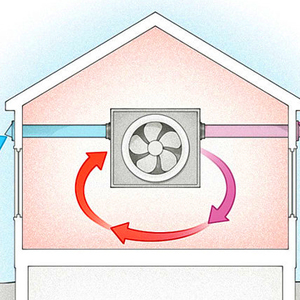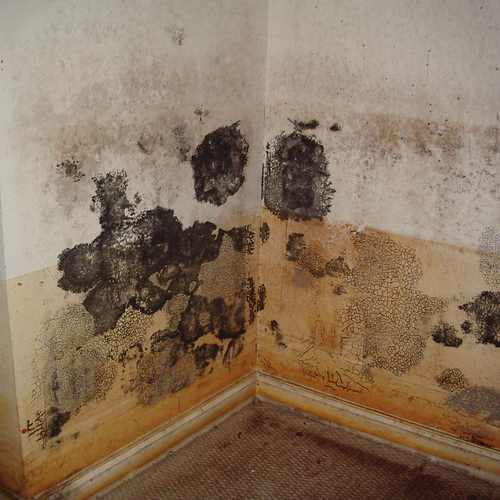
In recent weeks, many of us have become reluctant to use door handles and handrails in public spaces. Worried about the new coronavirus, we either avoid touching these surfaces, or wash our hands soon after we touch them.
Few architects and builders know that there appears to be a simple method for reducing the risk associated with these surfaces: specify and install copper door handles and copper handrails. Copper surfaces are antibacterial and antiviral. Since there is ample evidence that copper surfaces are less likely to harbor viruses or transmit viral diseases than stainless-steel surfaces, architects need to begin to implement this measure more widely.
In a recent GBA article titled “Building Science and the Novel Coronavirus,” Peter Yost wrote, “Building science and design can play an important role in reducing infections caused by Covid-19, influenza and many viruses: reducing the number of surfaces that people touch and installing easy-to clean surfaces that people will touch frequently. Think hand rails, door knobs, light switches.” Yost is correct, of course, but I would add to Yost’s advice: “Wherever appropriate, specify copper handrails and copper door handles.”
Architects should specify copper handrails and door handles in medical clinics, hospitals, and public spaces like subway stations and restaurants. But there may also be opportunities to use more copper surfaces in residential settings, especially for clients who are immuno-compromised or worried for other reasons about new viruses.
Most builders know that copper is an excellent material for plumbing pipes and chimney flashing; fewer realize that it can play a role in reducing the spread of infectious diseases. As a way to reduce the rate of viral infection, using copper surfaces counts as a green approach—a much more environmentally responsible approach than using chemicals to treat surfaces.
A 19th-century finding
A French physician,…
Weekly Newsletter
Get building science and energy efficiency advice, plus special offers, in your inbox.

This article is only available to GBA Prime Members
Sign up for a free trial and get instant access to this article as well as GBA’s complete library of premium articles and construction details.
Start Free TrialAlready a member? Log in















17 Comments
Martin, that's an interesting idea, and a simple way to improve safety. I'd add that most metal hardware comes with a lacquer finish, to prevent the metal from tarnishing too quickly. I've never spec'd copper door hardware but it's so prone to tarnishing that I'd be shocked if it didn't come with a coat of lacquer. The lacquer will eventually wear off, but wiping it down with lacquer thinner would be faster and more thorough. Just be ready for the shiny copper to look like a mottled old penny before long.
Michael,
Over its lifetime, a copper roof will have many colors -- starting out shiny and ending up a dull green. A copper door handle is like your copper cookware -- you can shine it up every now and then if you like the look of shiny copper, or just enjoy it the way it is, unpolished. A copper door handle will effectively kill viruses in either case -- shiny or dull.
Martin, my point, which I did not actually state, was that copper hardware coated in lacquer may not have the same anti-viral properties as unfinished copper. I'm really not sure either way--do you know?
Michael,
Your point is well taken.
You might want to re-read my article. Here is what I wrote (in the bullet points): "If the goal is to maximize the antimicrobial effectiveness of copper, the copper should not be coated with a varnish or other surface treatment."
Ah, thanks. I read it twice to make sure I wasn't missing something, but still missed it.
Michael,
I believe the anti-microbial properties of copper come from it's high electrical conductivity (silver is also anti-microbial). So if it were coated with something to prevent tarnishing, which would likely insulate it as well, that would ruin it's anti-microbial benefits. Perhaps some sort of copper alloy might be the answer, or maybe some clever architect could design the space so tarnished copper looks good! ;^)
Interesting topic.
For those who read this and might be responsible for a space where this could be an immediate opportunity, a fast way to deploy it could be to apply copper tape which is made for electrical shielding and is uncoated on the non-sticky side.
A random example: https://smile.amazon.com/dp/B07C6YLNYL/
It's also worth noting that copper is one of the easiest metals to electroplate, and there are many small metal finishing shops that can do it. So if you have trouble finding the handle or rail that you want with a copper finish at a reasonable price, that could be a good option. And it consumes a lot less copper than using a copper pipe.
Charlie,
Interesting idea! Thanks for the hint.
In these days of almost panic with COVID-19, I think your caveats are severely understated.
Many hardware manufacturers offer antimicrobial finishes which are silver-based. Silver, like copper, is a biocide. (Will kill almost anything under the "right" conditions.) But none of those manufacturers list antiviral properties in their literature, and that is by design.
I own a business that sells door hardware, and I have personally spoken with senior representatives from these manufacturers. While they readily promote antibacterial benefits of these materials, they do not claim and explicitly exclude references to antiviral benefits.
Pure copper with ABSOLUTELY NO coating MIGHT be affective against SOME viruses, but as you've already stated, some have already been shown to live for several hours on copper. I am not disagreeing that copper hardware could be beneficial. I am just stating my opinion that I think the caveats should be more forward and more emphasized, especially at this time.
Dan,
Concerning the question of whether silver rather than copper might be specified for hardware used in clinics and hospitals -- an unlikely suggestion, considering the cost of silver -- here is what the article in "The Conversation" noted: "When doctors are asked to name an antimicrobial metal used in healthcare, the most common reply is silver –- but little do they know that silver does not work as an antimicrobial surface when dry –- moisture needs to be present."
Although frequent hand contact with a silver surface might provide enough moisture to create an antibacterial effect, the presence of moisture is not required if copper rather than silver is specified.
The medical literature, including the papers linked to in my article, fully confirm that copper surfaces kill viruses -- not instantly, but in a matter of minutes or at most a few hours. Furthermore, clinical studies have shown that the antibacterial and antiviral nature of copper is strong enough to lower infection rates in hospitals when commonly touched surfaces like bed rails and door knobs are switched from stainless steel to copper.
I stand by my article.
I wonder if the anti-viral properties of copper are changed/diminished as it tarnishes. Does anyone have any thoughts on that?
Also, we have been specifying copper at the bottom of log storage areas to help kill insects that might be in the logs. I haven't done any follow up on that to see how effective it is.
Nathan,
According to Michael Schmidt, a professor of microbiology and immunology at the Medical University of South Carolina, "Copper is antimicrobial regardless of how grody it looks; if it turns green on you, it still has the ability to kill bacteria and viruses and fungi.”
Martin,
I was really intrigued by your recent piece on the potential antimicrobial properties of copper, including door hardware, railings, kitchen & bathroom fixtures, etc., intrigued enough to start researching products, including those employing CuVerro® bactericidal copper alloy, a product developed by Olin Brass and purportedly "recognized by the EPA to protect people against disease-causing bacteria."
However, it didn't take too long before I stumbled across reference to this 2014 study from the University of Leicester reporting that human sweat, including "sweaty hands" seriously compromises copper's antimicrobial properties. (https://www2.le.ac.uk/offices/press/press-releases/2014/june/groundbreaking-research-finds-human-sweat-can-reduce-bacteria-defences-in-hospitals-and-schools).
It seems that human sweat forms a corrosive layer on the copper (or brass/bronze) surface that blocks the exchange of charged particles that would otherwise kill harmful microorganisms, such as viruses and bacteria, on contact. So, according to the researchers, using copper fixtures doesn't reduce the need to clean them, nor reduce the need for good hygiene practices, such as regular hand-washing. Apparently, studies touting the very real antimicrobial effects of copper tend to assume that the microorganisms will come into direct contact with an unadulterated copper surface (where the ion exchange would occur), but fail to account for the possibility that, in real-world environments, harmful microbes would likely encounter a chemical barrier, from salt-based sweat, that insulates them from copper's germ-killing ions -- a sort of natural "surface treatment". This all suggests that copper hardware, including self-fabricated fixtures with plumbing materials, are not as effective at killing germs as hoped.
But the University of Leicester researchers did suggest that using copper alloys with corrosion inhibitors included in the alloy would be a good choice. "Anywhere that needs to prevent the spread of bacteria, such as public buildings, schools and hospitals should be looking at using copper alloy on everyday items to help in avoiding the spread of disease.” I suspect this is what Olin Brass is doing with CuVerro. A number of manufacturers are now using CuVerro in their products, including these folks: https://www.rockymountainhardware.com/specialties/antimicrobial
John Hall
John,
Thanks for the helpful information and the link to Dr. John Bond's study.
Dr. John Bond from the University of Leicester states that corrosion inhibits the antimicrobial effects of copper, while Michael Schmidt from the Medical University of South Carolina claims that corrosion does not inhibit the microbial effects of copper. I'm not sure which of these experts is correct, but I certainly agree with Dr. Bond that "more research is needed in the study of sweat and brass corrosion."
I also agree with you on the need to keep hardware clean -- which is why I noted in my article that "Copper bedrails, handrails, and door handles in medical facilities still need to be cleaned regularly, just like any other surface in a hospital room."
Thanks for the link to a supplier of CuVerro hardware.
There is another naturally antimicrobial product that was used for years long ago and is making a comeback in environmentally aware homes.
Flooring made from old fashioned Linoium like my grandmother had in the kitchen. It also gets better by the day as it gets more durable as it gets older. It is non-toxic and is made from natural products. We installed some and it is working great. Had to install it ourselves 15 or so years ago as installers were very hard to find then, less so now. Looking to do another room soon. Who would have thought such a humble product has so much going for it.
Martin,
Another recent article, citing research by Professor Schmidt and Professor Keevil from the UK's University of Southhampton, just appeared in the latest issue of Smithsonian Magazine. https://www.smithsonianmag.com/science-nature/copper-virus-kill-180974655/.
Dr. Keevil's research appears to provide strong confirmation of Michael Schmidt's findings (and seemingly undercut the report from University of Leicester warning that human sweat on doorknobs and railings might insulate microorganisms from copper's antimicrobial properties.)
In particular, note this quote from Professor Keevil: Keevil’s team checked the old railings at New York City’s Grand Central Terminal a few years ago. "The copper is still working just like it did the day it was put in over 100 years ago," he says. "This stuff is durable and the anti-microbial effect doesn't go away."
The argument for installing copper alloy fixtures (e.g., CuVerro) not only in healthcare institutions but in housing occupied by seniors and the medically fragile is looking pretty compelling. (That's what we've decided to do in the downsized retirement home we're building in Vermont's Northeast Kingdom.) And maybe fabricating railings from copper plumbing materials makes sense after all. I don't think our fixtures will see as much traffic as Grand Central!
John Hall
John,
The brass handrails at the stairway in Grand Central Station are famous -- and, as you point out, are still antiviral after all these years.
Log in or become a member to post a comment.
Sign up Log in